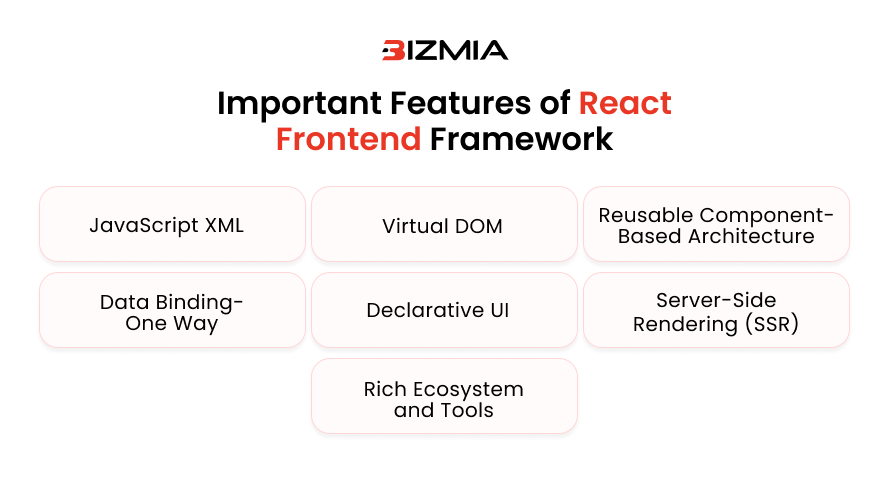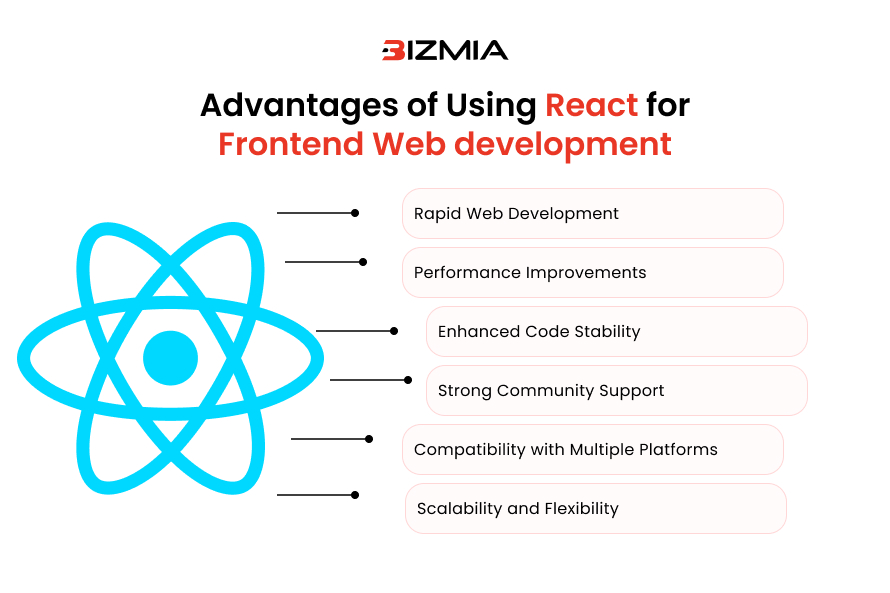A front-end framework, React, which is designed and maintained by Facebook, is a top choice among developers and enterprises. This is because of its flexibility, strong ecosystem, and efficiency. This blog explores in detail all the key features of the React frontend framework, the top benefits of React, and the reasons behind its popularity.
Is React a Frontend Framework
Let’s start this guide by addressing a key question ‘Is React a frontend framework?’ It is a JavaScript library used for designing user interfaces, particularly in single-page web applications. Although it is technically a library, its dynamic tools and other useful features elevate it to the status of a front-end framework for web development.
Important Features of React Frontend Framework
React has several significant features that make it a useful platform, including JavaScript XML, virtual DOM, component-based architecture, one-way data binding, declarative UI, tools and rich ecosystem, and SSR. See each of them in detail below:

1. JavaScript XML (JSX)
A syntax extension, JSX, enables developers to write HTML elements in JavaScript programming language. With this blend of logic and markup, your code readability improves, making the web development process smooth and more intuitive.
Moreover, JavaScript XML offers better debugging and error handling during compilation. This thing is particularly essential for building complex web apps. For assistance in building such complicated apps, you can hire trusted React developers.
2. Virtual DOM
The use of virtual DOM by React is one of its useful innovations. A lightweight copy of the actual DOM is created by the React framework rather than upgrading the entire web page every time, in case of any alteration. It helps in improving your app performance by resulting in faster rendering.
3. Reusable Component-Based Architecture
The architecture of React is built on reusable components. With its rendering and logic, each component is a self-contained unit. So that developers can create web applications in a modular manner. It makes the development process faster, simplifies testing, and promotes code reuse.
4. Data Binding-One Way
A unidirectional data flow is utilized by the React front-end framework. In this type of data flow, data flows from the parent component to the child component in a single direction. It ensures easier debugging and understanding of the data lifecycle. Also, this approach leads to more predictable and stable applications.
Are you planning to leverage dynamic React features?
5. Declarative UI
Developers can design views for each state of the application with React, and it can handle UI updates with any change in data. Due to this declarative nature, React can make code more readable, reduce bugs, and minimize programming complexities.
6. Rich Ecosystem and Tools
The rich ecosystem of React possesses strong libraries like Next.js for taking care of server-side rendering, React Router for navigation, and Redux for state management. With such tools, you can easily build scalable, complex web applications by significantly expanding React capabilities.
7. Server-Side Rendering (SSR)
Through multiple frameworks like Next.js, the React framework supports server-side rendering, much like how various PHP frameworks are used on the server side to boost performance and scalability. This way, it becomes possible to improve SEO and minimize the time-to-interactive for web users. Moreover, due to SSR, React applications get a higher ranking on search engines.
Advantages of Using React for Frontend Web Development
By choosing React for front-end web development, you can have multiple benefits, including faster web development, performance improvements, enhanced code stability, strong community support, cross-platform compatibility, and scalability.

1. Rapid Web Development
Developers can build applications quickly due to the vast library of React and reusable components. Also, it gets easier for teams to minimize repetitive tasks and speed up the web development cycle.
2. Performance Improvements
The virtual DOM of React ensures that only those components are re-rendered that have changed. It reduces load times and side by side, ensuring a seamless experience for users, in the case of data-driven applications as well.
3. Enhanced Code Stability
The one-way data flow of React facilitates tracking changes and debugging. Usually, child components cannot change the state of parent components directly, which minimizes side effects and contributes to making applications stable.
4. Strong Community Support
The active and large community of dedicated developers of React offers an extensive range of forums, libraries, documentation, and tutorials. These things facilitate developers to stay updated with the latest developments, adopt best practices, and find solutions.
5. Compatibility with Multiple Platforms
The React framework is not limited to the web. Developers can also design mobile applications for Android and iOS with the help of the same design principles and code base. This results in reduced cost and time for the whole development process.
6. Scalability and Flexibility
The modular nature of React applications makes them highly scalable. It means that your app can evolve with your business expansion by integrating with the latest technologies and adding new components. All of this is possible without even writing a single code.
Why is React So Popular?
All the hype of React is attributed to its flexibility, performance, and simplicity. This framework’s component-based architecture is one of the major reasons behind its popularity among developers. This helps in improving modularity and reusability. Moreover, developers can split complex user interfaces (UIs) into smaller pieces that are easily manageable and easier to debug, scale, and maintain.
Another considerable factor behind the popularity of React is its virtual DOM, enabling React to update the UI effectively and quickly. It results in enhanced performance. In addition, data flow in a single direction ensures a predictable structure, facilitating change detection in the data structure. All these useful features and a lot more are the key reasons making React a famous front-end framework. You can hire dedicated React JS developers to leverage this medium.
React Native: Building Mobile Applications
An extension of React, React native frontend framework that enables web developers to design native mobile applications using React and JavaScript principles. It also offers access to native components and APIs, ensuring a near native performance for mobile apps. That’s why React native has become an excellent choice for companies that want to cater to both Android and iOS users.
Moreover, with React native, developers can easily write code once and implement it across multiple platforms. Different features enhance the productivity of developers; such features include hot reloading. The access provided by native modules enables the integration of device-specific functionalities like push notifications, geolocation, and camera access. That’s why this extension is widely used by big companies like Shopify, Uber, and Facebook.
Some Best Use Cases of the React Frontend Framework
We are jotting down some practical use cases of the best React frontend frameworks here:
- Single-Page Web Applications: Due to fast data updates and dynamic UI rendering, React is the best fit for building single-page web applications.
- E-Commerce Platforms: A scalable and interactive shopping experience on multiple e-commerce platforms is also possible with React.
- CMS: Highly customizable and modular content management systems interfaces are designed with React
- Admin Panels and Dashboards: Feature-rich dashboards are designed using the React framework
- Social Media Apps: Different interactive chat features, social feeds, and notification systems are built with ease
- Real-Time Data Applications: Various real-time applications, such as stock trading dashboards and analytical platforms, are also created by React.
How to hire Dedicated ReactJS Developers?
It’s crucial to hire React developers with the right technical expertise and practical experience if you want to speed up your project’s success. It all depends on your project requirements. You might select freelancers or in-house teams or take dedicated ReactJS developers on board from web development agencies.
The Best React Frontend Frameworks and Libraries
Some best React frontend frameworks and libraries include Next JS, Redux, Gatsby, React Router, different UI libraries, Formik, and Yup.
1. Next JS: A dynamic framework for server-side rendering, hybrid apps, and static site generation, suitable for high-performance and SEO-optimized websites.
2. Redux: A famous state management library making it easy to handle complex application states and widely adopted by enterprise-level React applications.
3. Gatsby: A suitable framework for designing fast static websites. It also integrates well with different content management systems such as Contentful or Strapi.
4. React Router: It allows dynamic routing in single-page web applications, ensuring smooth navigation is possible without full-page reloads.
5. Formik and Yup: These React libraries make handling and form validation easy. Such libraries also facilitate user input management.
Wrapping Up
Modern web development practices are redefined by the React frontend framework, by offering an efficient, scalable, and modular approach. The combination of versatility, performance, and developers’ productivity makes React a go-to choice for enterprises and startups alike. It also remains a future-proof solution for companies demanding engaging, cross-platform, and faster digital experiences.
FAQs
1. Is React a backend or frontend framework?
This is a JavaScript-based frontend web framework, widely used for building interactive and dynamic user interfaces. It is not created for back-end web development.
2. Why should I select React over other frontend frameworks?
You can opt for React over other front-end frameworks due to its better performance, reusable components, and faster rendering, making it a top choice for advanced web applications.
3. Can I use React for designing web applications?
Yes, React native can be used to design mobile applications for both Android and iOS by using only a single code base.
4. What are the top benefits of React frameworks?
The top benefits of using the React framework include strong community support, scalability, virtual DOM, cross-platform compatibility, performance optimization, and component reusability.












